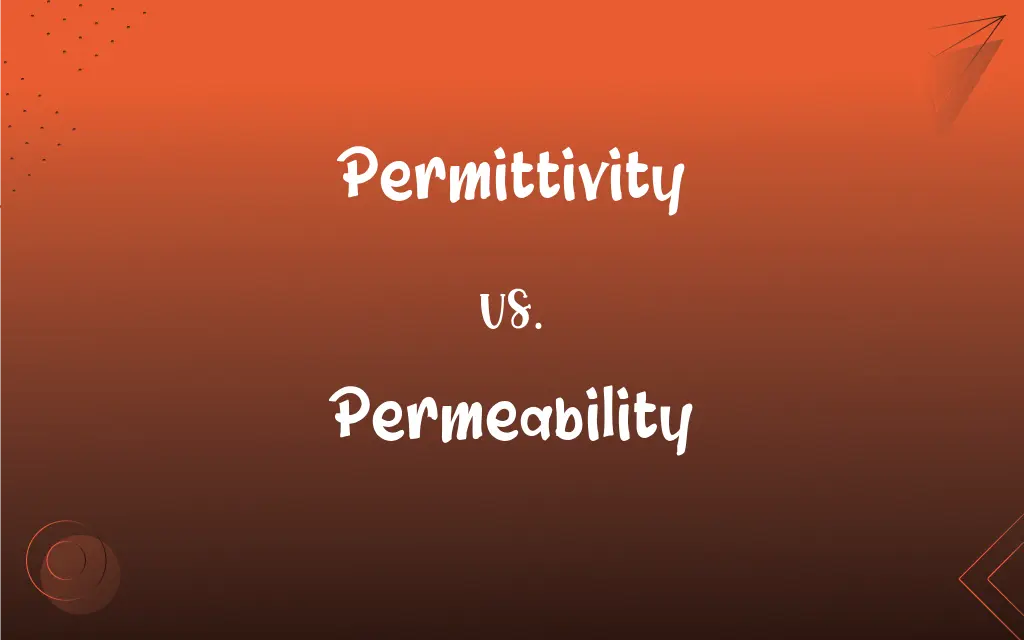Permittivity vs. Permeability: What's the Difference?
Edited by Aimie Carlson || By Harlon Moss || Updated on October 9, 2023
Permittivity measures a material’s ability to store electrical charge, often denoted by the Greek letter epsilon. Permeability gauges a material’s ability to support magnetic field development, symbolized by the Greek letter mu.

Key Differences
Permittivity is inherently associated with electric fields and the formation or storage of electrical charge within a material. In contrast, permeability is intertwined with magnetic fields, concerning itself with the propagation of these fields through a specific material.
The unit of permittivity, farads per meter (F/m), emphasizes its role in capacitive effects in electrical circuits. On the flip side, permeability is measured in henries per meter (H/m), elucidating its connection to inductance and magnetic circuits.
When discussing permittivity, we often encounter the term "dielectric constant," especially when dealing with capacitors in electronics. Whereas, discussions on permeability may pivot towards "relative permeability" when delving into materials’ magnetic properties.
Permittivity is crucial in the study of electrostatics, affecting the force between electric charges and capacitive energy storage in electrical fields. Conversely, permeability is paramount in magnetostatics, influencing the behavior and propagation of magnetic fields.
In materials, permittivity usually comes into play when evaluating how well a material can permit an electric field, affecting phenomena like polarization. In a similar manner, permeability is significant when assessing how well a material supports the formation of magnetic fields, affecting phenomena such as ferromagnetism.
ADVERTISEMENT
Comparison Chart
Syllables
5
6
Part of Speech
Noun
Noun
Rhyming Words
Competitivity, conductivity
Impeachability, teachability
Grammatical Variations
Permittivities (plural form)
Permeabilities (plural form)
Permittivity and Permeability Definitions
Permittivity
A measure indicating how an electric field affects and is affected by a dielectric medium.
Air, having low permittivity, is a common insulator in various applications.
ADVERTISEMENT
Permeability
A coefficient indicating the induced magnetization of a material in response to an applied magnetic field.
Permeability plays a vital role in determining the magnetic response of materials in inductive components.
Permittivity
A property determining the electric displacement in a material in response to an applied electric field.
The permittivity of vacuum serves as a reference point in electrostatic equations.
Permeability
The degree to which a substance allows the passage of magnetic flux.
The high permeability of certain alloys is utilized in developing efficient electromagnetic shielding.
Permittivity
A parameter affecting the speed of light and electromagnetic wave propagation through a medium.
The permittivity of the medium dictates the phase velocity of propagating electromagnetic waves.
Permeability
A measure indicating the ability of a material to support the formation of a magnetic field within itself.
Ferromagnetic materials exhibit high permeability under specific conditions.
Permittivity
The capability of a material to store electric charge.
The permittivity of the dielectric material influences the overall capacity of the capacitor.
Permeability
The quality of a material that allows magnetic lines of force to pass through it.
The permeability of iron is high, making it a choice material for magnetic core construction.
Permittivity
The quotient of the electric field and the electric flux density in a given material.
Researchers often manipulate permittivity to develop better insulating materials.
Permeability
A term depicting how easily a magnetic field can penetrate and establish itself within a material.
The permeability of a material impacts its efficacy in various electromagnetic applications.
Permittivity
A measure of the ability of a material to interact with an electric field and become polarized by the field, weakening the field within the material. The permittivity of a material is the product of the dielectric constant of the material and the permittivity of a perfect vacuum, which is defined to be about 8.854 × 10-12 farad per meter.
Permeability
The property or condition of being permeable.
Permittivity
(physics) A property of a dielectric medium that determines the forces that electric charges placed in the medium exert on each other.
Permeability
The rate of flow of a liquid or gas through a porous material.
Permeability
The property of being permeable.
FAQs
Is permittivity crucial in capacitor design?
Yes, the permittivity of the dielectric material influences the capacitance and performance of a capacitor.
Does permittivity involve electric fields?
Yes, permittivity relates to the ability of a material to store electric charge in an electric field.
Can the permittivity of a material be altered?
Yes, certain conditions, like temperature changes or impurity introduction, can alter permittivity.
How does the concept of permittivity relate to Coulomb’s Law?
Permittivity appears in Coulomb's Law as a scaling factor in the denominator, mediating the electric force between two charges based on the medium in which they interact.
Are there materials that can be described as having negative permeability?
Yes, certain engineered metamaterials can exhibit negative permeability, influencing electromagnetic waves in unusual ways, such as achieving negative refraction.
Does higher permittivity imply better insulation capabilities?
Yes, materials with higher permittivity generally provide better electrical insulation.
How does permittivity influence the speed of light in a medium?
The permittivity of a medium affects the phase velocity of light and electromagnetic waves through it.
Is permittivity dependent on the frequency of an applied electric field?
Yes, permittivity can depend on frequency, especially in materials that exhibit dielectric dispersion.
What is the unit of measurement for permeability?
Permeability is measured in henries per meter (H/m).
Can permeability values change with temperature?
Yes, permeability can be temperature-dependent, particularly in ferromagnetic materials.
Is permeability relevant in the context of electromagnets?
Yes, permeability is vital in determining the magnetic field strength and efficiency of electromagnets.
In what units is permittivity expressed?
Permittivity is expressed in farads per meter (F/m) in the International System of Units (SI).
Does permittivity play a role in the transmission of electromagnetic waves through a medium?
Yes, permittivity affects the propagation speed and attenuation of electromagnetic waves as they travel through a medium.
Does permeability relate to inductance in electrical circuits?
Yes, permeability influences the inductance in electrical circuits, especially in inductors with magnetic cores.
What is “relative permeability” in the context of materials science?
Relative permeability refers to the ratio of a material’s permeability to the permeability of free space, quantifying how effectively it can support a magnetic field.
How does the permittivity of a material influence its electric susceptibility?
The permittivity of a material and its electric susceptibility are directly related, with susceptibility representing how much polarization occurs in response to an applied electric field.
What role does permeability play in the operation of transformers?
Permeability is crucial in transformer cores, influencing the magnetic flux linkage between the primary and secondary windings and thus the efficiency and functionality of the transformer.
In what kinds of materials is magnetic permeability typically highest?
Magnetic permeability is typically highest in ferromagnetic materials, such as iron, cobalt, and nickel.
How does permeability impact magnetic fields?
Permeability indicates how well a material allows the development and propagation of magnetic fields.
Can the permeability of materials be enhanced or modified for technological applications?
Absolutely, material permeability can be enhanced using various treatments, alloying, or manufacturing techniques.
About Author
Written by
Harlon MossHarlon is a seasoned quality moderator and accomplished content writer for Difference Wiki. An alumnus of the prestigious University of California, he earned his degree in Computer Science. Leveraging his academic background, Harlon brings a meticulous and informed perspective to his work, ensuring content accuracy and excellence.
Edited by
Aimie CarlsonAimie Carlson, holding a master's degree in English literature, is a fervent English language enthusiast. She lends her writing talents to Difference Wiki, a prominent website that specializes in comparisons, offering readers insightful analyses that both captivate and inform.
































































